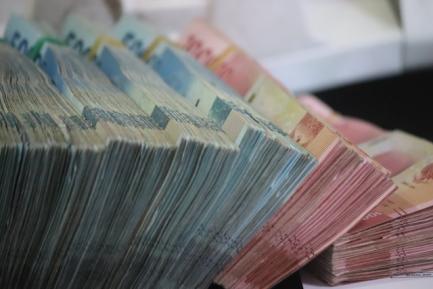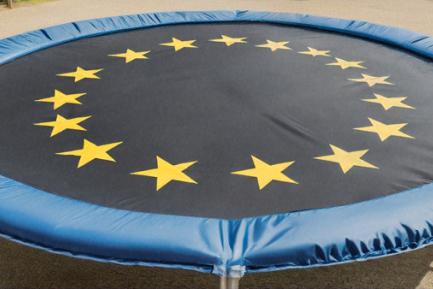Sustained but moderately paced growth
The euro area continues to consolidate its recovery although growth is not speeding up. The second revision for GDP growth increased the figure by 0.1 pps in the first two quarters of the year to 0.4% growth quarter-on-quarter in Q2 (0.5% in Q1). Over the coming months we expect the recovery to continue at a similar rate to Q2, placing GDP growth at 1.5% and 1.8% annually for 2015 and 2016 respectively. Our current growth scenario for the euro area is very similar to the one used by the ECB which, in September, revised downwards its outlook for growth compared with the figures announced three months ago, to 1.4% in 2015 and 1.7% in 2016. Both our forecast and the ECB's suggest that the recovery will continue on track in spite of the slowdown in the emerging economies. The institution also predicts that the gradual rise in inflation will ease off slightly due to the drop in oil prices. Regarding the uncertainty generated in the last few months due to the situation in Greece, the outcome of the recent parliamentary elections is cause for some optimism. Syriza's ample victory, with a mandate to implement the third financial assistance programme, should help it to succeed and reduce this source of instability.
The breakdown of GDP for Q2 shows almost zero contribution from domestic demand to growth. Specifically, its contribution was 0.03 pps as a consequence of the drop in investment and stocks since household private consumption remained quite strong. In Q2 foreign demand was therefore the largest contributor (with 0.3 pps), supported by the good performance of exports although leading indicators for consumption and investment suggest that domestic demand will pick up again over the coming months.
Slight improvement in economic activity in Q3. The good performance by the euro area's economy can be seen in the composite PMI activity index which has remained in the expansionary zone in spite of September's slowdown (by 0.4 percentage points to 53.9 points). For Q3 as a whole, the index accelerated its rate of expansion slightly up to 54.0 points compared with the 53.9 in Q2. The picture differs slightly from country to country. On the one hand the German index posted some improvement in Q3 compared with the previous quarter and the German IFO (business climate index) provides the same picture, whose average from July to September (108.3 points) was 0.1 pps higher than from April to June. On the other hand the slowdown in the French PMI in Q3 is cause for concern as the country was already at a rather contained level. Other activity indicators also suggest that the euro area's recovery is likely to continue at a similar rate to that seen in Q2 and industrial production continued its upward trend, rising by 1.2% year-on-year in July (seasonally adjusted). Of note is the strong growth recorded in Spain, Italy and Portugal, of 5.0%, 2.4% and 1.3%, respectively, reaffirming that activity in the periphery, with the exception of Greece, continues to look healthy. , France's figure was negative, however, falling by 1.1% year-on-year in July, a trend which, if it continues, points to French investment performing badly in Q3.
The French government presents the 2016 Budget. The expected reduction in the deficit, from 3.8% this year to 3.3% next year, is supported by a feasible macroeconomic situation with moderate growth in GDP (1.0% in 2015 and 1.5% in 2016) and also inflation, (0.1% and 1.0%, respectively), in line with our forecasts. The cuts in fiscal expenditure totalling 16 billion euros seem ambitious at first, especially after the measures announced which contain aid for the agricultural sector and an increase the number of civil servants (in particular in defence). According to the French government's scenario, debt will increase to 96.5% in 2016, 0.2 pps more than in 2015. The public accounts, however, will not improve without greater economic consolidation and a bigger recovery of the competitiveness lost by the French economy. The government seems to be aware of this, announcing reforms for the coming year in key areas such as the labour market, although their extent has yet to be specified.
Consumption was still strong in Q3 in the euro area as a whole, supported by the gradual recovery in the labour market. Retail sales posted a notable rate of growth in July of 2.7% year-on-year (2.2% in Q2). The euro area's consumer confidence index has also remained at a considerable level, in spite of falling slightly in Q3 and the improved performance by employment is helping the recovery in consumption. In fact, the figures show a slight acceleration in employment's growth rate in the euro area, up by 0.3% quarter-on-quarter in 2015 Q2 (0.2% in Q1). Moreover the euro area's unemployment rate stood at 11.0% in August, 0.5 pps below the figure for the same month one year ago. Looking at the second half of the year, the employment expectations surveyed by the European Commission point to the labour market continuing its good performance, especially in the services sector. If this comes about, these improved employment expectations will help to boost household consumption.
The periphery is recovering part of the competitiveness it lost, through wages. The increase in wage costs in the euro area, namely 1.9% year-on-year in Q2, speeded up slightly compared with the same quarter one year ago (1.5%). This figure hides a highly disparate trend between countries, however. Significant wage rises can be seen in Germany, where unemployment is rock bottom (3.3% year-on-year in Q2) while increases are much more subdued in Italy and Spain, namely 0.0% and 0.7% respectively. Moreover, the wage rises recorded over the last few months, especially in Germany, have been higher than the increase in prices, allowing workers to gain purchasing power and increase their consumption capacity.
Inflation takes a surprising dip and returns to negative figures. In September the year-on-year change in the harmonised index of consumer prices (HICP) for the euro area fell by 0.2 pps, reaching –0.1% after five consecutive months in positive figures. This drop is due to the considerable reduction in the energy component (of 8.9%), somewhat larger than expected, although core inflation remained at a moderate level (0.9%). The breakdown of HICP for goods by level of inflation helps to determine whether this low inflation is widespread or due mainly to a drop in price of a specific component such as energy. The breakdown shows that the proportion of goods with negative inflation has fallen in the last few months, indicating there are fewer goods in this situation and that oil is therefore the main reason for low inflation. With a view to the end of the year, however, inflation should recover as the base effect disappears of the downward slide in oil prices, which started at the end of 2014. Core inflation should also continue to rise given the greater push by domestic demand and more expensive imports because of the euro's depreciation.
The foreign sector is still an important support for economic growth. The euro's depreciation in the last few quarters has been helping to improve the price competitiveness of the euro area's products, boosting sales abroad. In fact, exports of goods from the euro area to the rest of the world rose at a good rate and reached 6.8% year-on-year in July (7.7% in Q2) while imports grew by a much lower rate (1.3%). This brought the trade balance to 31.4 billion euros in July, a significant advance compared with the same period last year (21.2 billion). This surplus in the goods account is helping the euro area's current account to maintain a good balance and we expect the foreign sector's contribution to GDP growth to remain positive in the future. However, it is vital for the impact caused by the slowdown in the main emerging economies to be moderate in scope and temporary, as expected.
The spread between different countries' financing costs for firms continues to shrink. The monetary policy measures implemented by the ECB have helped to improve confidence in a generalised recovery of the euro area, narrowing the spreads between countries in interest rates applied to bank loans for non-financial firms. In Spain and Italy these costs were 3.3% and 2.9% respectively in July compared with 4.6% and 4.0% the same month one year ago. The reduction in Germany was smaller, however, standing at 2.6%. These low financing costs are supporting a gradual increase in credit in the euro area. Specifically, according to data from the ECB, the year-on-year growth in loans to the private sector speeded up to 1.4% in July (compared with 0.9% in Q2). In spite of this improvement, the volume of credit is still historically low but should gradually rise as the economy recovers and financing conditions improve.










